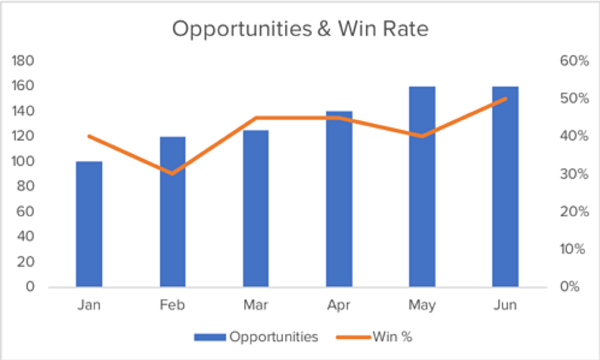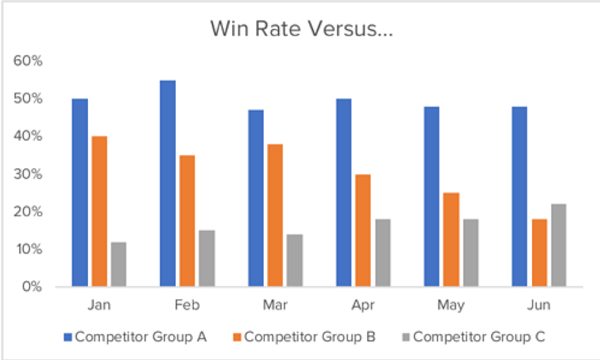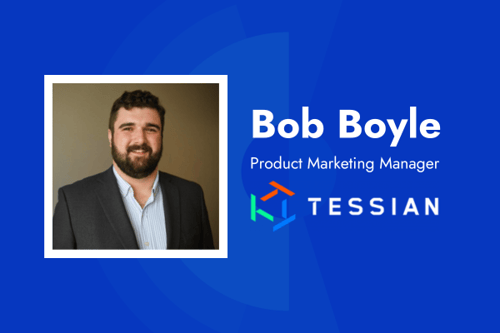Ah, the internal sales meeting. Whether it’s weekly, monthly, or quarterly, nearly every product marketer needs to present to the rest of their sales team about what’s going on in their world. The trouble with update meetings is that they are repetitive in nature—you usually cover the same stuff each time. While there should be “updates” to the subjects you cover each week (or month), if the information you’re sharing isn’t resonating, then your colleagues will tune you out.
Before we dive into what to include in your presentation, there are three key overarching recommendations to keep in mind:
- Keep it Short: An update meeting isn’t for providing a laundry list of everything you’re working on. Only talk about things that are impactful and useful for the rest of the team.
- Use Visuals: If you can demonstrate your point with a visual, then do that.
- Be Transparent: If the results aren’t great, then be honest about it. Pretending everything is rosy will make your colleagues tune you out and not trust you. Tell the truth—they will appreciate it.
While I’m referring to internal meetings with the sales team, these features can be applicable to multiple teams across the company including product, people ops, customer success, etc.
 #1: How We Doin’? Dive into Win Rate
#1: How We Doin’? Dive into Win Rate
Back in my HubSpot days, Brian Halligan used to (and probably still does) a “How We Doin’?” section at the company meeting. “How We Doin’?” consisted of him diving into how we were doing as a company—how much revenue did we bring in, how many new customers, how churn was doing, etc. Not only was it helpful and transparent, but it made everyone feel like they had a responsibility toward these metrics, no matter their role.
As a product marketer, you can have a similar “Halligan” effect by presenting on your win rates. Win rate is a measurement of your sales team’s success rate, and it often more closely reflects product marketing’s efforts as opposed to a metric like overall revenue.
When presenting win rate, you’ll want to show the data sliced in different ways to help your sales team understand where your strengths lie and where there are opportunities for improvement. Here are a couple of ways to look at your win rate:
- Overall Win Rate: The overall measurement of your sales team’s success rate. Win rate is calculated by the # of won opportunities / total # of opportunities. When presenting, you’ll want to show a graph of the total # of opps and the percentage of those opportunities that were won.

- Competitive Win Rate: The measurement of deals you are winning against your competitors. Competitive win rate will help shed a lot of light on how you’re actually doing in head-to-head deals rather than just anecdotal sales rep data—a couple of lost deals in a row can feel like the end of the world and may drive a narrative that you’re losing a lot of deals to your competitor, when that may not be the case. Showing how you’re doing against your competitors will help set the record straight and give your team insight on how you’re doing in head-to-head deals.

You can also include win rate by sales team, vertical, segment, etc. but keep it only to the information that you think your team will find it important. Again, you don’t want people tuning you out.
#2: Customer of the Week
Customers should always be the center of what you do as a product marketer, so why not take time to celebrate your best customers?
Customer of the Week is a segment of your presentation where you highlight a specific customer who perfectly fits your persona and use case. Here’s roughly what a Customer of The Week should include:
- Name of the company
- Name and position of the specific user (this helps humanize the customer)
- The need: before your solution, what were the problems the customer was facing? This should reflect the problems your typical persona faces
- The solution: how your solution helped the customer solve their problems. Give detail on how specific features helped the customer, or features that they personally love
Customer of the Week is a great way to reiterate your key value drivers and use cases for your sales team and foster a “customer-first” culture.
#3: Competitor Updates
Everyone wants to know about what the competition is doing, especially sales people. Typically product marketers tend to focus on feature updates from competitors, and while those are extremely important and should be covered in a sales update meeting, you may want to think about including some of these less-thought-of things:
Online Product Reviews
Product reviews are an excellent source of competitive intelligence because it offers an unfiltered view of how your competitors’ customers view them. If your competitor has a lot of reviews, pick out one that highlights your key value props—for example, let’s say you have excellent customer support as part of your offering, and your competitor does not. Take screenshots of reviews that point out the lack of support—that will reiterate your competitive advantage to the rest of the team.
Websites like G2, TrustRadius, and Capterra are excellent sources for product reviews.
Messaging & Positioning Updates
Presenting on where your competitor is going is something that most people in your organization will want to hear about, and that information usually lies in small messaging and positioning changes on a competitor’s website. Showing these changes and providing additional context at your update meeting will help your sales colleagues understand competitor movements and the ways their specific team may need to adjust—they may need to slightly alter their pitch, avoid certain “landmines” in a demo, etc.
Here are some insights you can feature in your presentation:
- Changes to Website Product Pages: Product pages are a great source of intel that can tell you how a competitor is shifting their strategy. For example, if they remove a line about 24/7 customer support, that might tell you they are potentially looking to redo their packaging and only offer support to higher tier customers.
- New Pages or Sections Added/Removed: Similar to product page changes, adding or removing pages can also hint at where a competitor might be headed with their messaging.
- Changes to Third-Party Profiles: Another signal that will tell you what your competitor is up to is how they are presenting themselves in their profiles across social media and other third-party channels. Any updates made to a competitor’s profile often indicates a significant shift in strategy—something you should always be aware of the moment it happens.
It’s important to add context to these updates and not simply list a bunch of changes your competitor made to their website. Sales won’t find that useful. Tell them exactly what these changes mean and how it those changes will affect them.
Putting Your Presentation Together
Despite that being a lot of information, your presentation should be short and simple. Here’s an example outline:
- Agenda
- How We Doin’?
- Win rate
- Competitive win rate
- Customer of the Week
- Who they are
- The Need
- The Solution
- Competitor Updates
- Product/feature updates
- Messaging & positioning updates
- Featured Third-Party Review
- Big Updates
- Any big projects that the rest of the team must know about—big initiatives only!
As mentioned in the beginning, keep your presentation short, use visuals where you can, and be transparent about the numbers so that you can deliver the perfect weekly product marketing update.

Related Blog Posts
Popular Posts
-
 The 8 Free Market Research Tools and Resources You Need to Know
The 8 Free Market Research Tools and Resources You Need to Know
-
 How to Measure Product Launch Success: 12 KPIs You Should Be Tracking
How to Measure Product Launch Success: 12 KPIs You Should Be Tracking
-
 24 Questions to Consider for Your Next SWOT Analysis
24 Questions to Consider for Your Next SWOT Analysis
-
 How to Create a Competitive Matrix (Step-by-Step Guide With Examples + Free Templates)
How to Create a Competitive Matrix (Step-by-Step Guide With Examples + Free Templates)
-
 6 Competitive Advantage Examples From the Real World
6 Competitive Advantage Examples From the Real World



